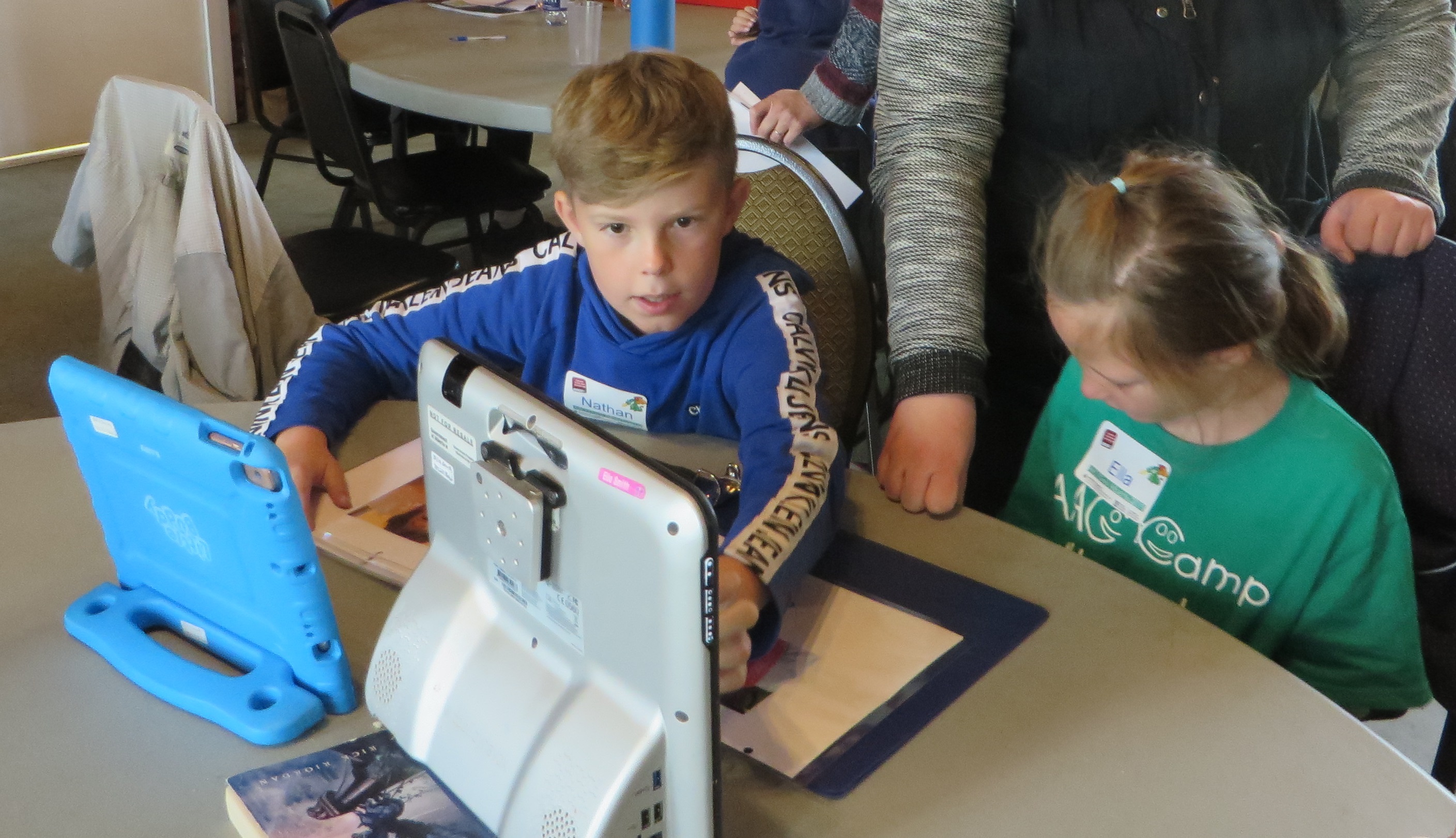
Siblings Nathan and Ella work through a fun activity together using Ella's speech generating AAC device at the 4th annual AAC Camp Alberta. (Photo supplied.)
(Bragg Creek, Alberta) Nathan Smith's goal is to talk to his nine-year-old sister for 10 minutes every day.
For most 11-year-olds, this doesn't sound like much of a goal, but Nathan's sister Ella, who has Rett syndrome, communicates through an augmentative and alternative communication (AAC) device. The two, along with their parents Katie and Chris, and little sister Amy, 5, attended this year's AAC Camp Alberta-and it helped Nathan achieve this goal.
"I liked the camp even better this year. I would like to spend even more time with my siblings," says Nathan. Ella lost her language when she was around two years old after developing about 30 words. She started using AAC strategies with the picture exchange system, where she indicated items she wanted using symbols on cards and her family gave her the items, and got her first AAC device in kindergarten, where she used her eye gaze to select communication symbols on a computer screen. The Smith family has been attending AAC Camp Alberta for the past three years.
The 4th annual AAC Camp Alberta was held at Easter Seals Camp Horizon in August. Hosted by the University of Alberta and March of Dimes Canada, the camp provides opportunities for children who use augmentative and alternative communication to connect, communicate and build friendships with one another.
This year's camp included 20 children from 6 to 17 years of age who each use a speech generating AAC device. Also participating were 12 siblings (5 to 16 years of age) and 36 parents and caregivers. Campers participated in a wide range of fun activities such as high ropes, pedal bikes, swimming, archery, music and movement, and messy play. There were also evening campfires and new this year, a dance night!
Campers using AAC were paired with U of A graduate students from the Faculty of Rehabilitation Medicine in the MSc. Speech-Language Pathology (SLP) program, who modeled the use of their communication device and encouraged social communication with peers during activities. MSc. Occupational Therapy students also assisted campers and SLP students in adapting activities and supporting the use of sensory strategies. Parents and caregivers attended training sessions and networked with other parents.
This year, as part of their CSD 900 project, supervised by Karen Pollock, a professor in the Department of Communication Sciences and Disorders (CSD) and rehabilitation associate professor Kim Adams, a group of SLP students focused on enhancing the sibling experience at AAC Camp.

Nine-year old Ella communicates through an augmentative
and alternative communication (AAC) device. (Photo supplied.)
"They first interviewed siblings who participated in the 2018 camp, and based on their feedback created a series of activities for siblings at this year's camp," explains Pollock. "Siblings learned how to find words on an AAC device during a scavenger hunt activity (they had to provide clues to their teammates using the device) and a barrier game using playdough (one had to use an AAC device to instruct another in how to re-create a playdough figure from a picture)."
Tara McPhedran, second-year SLP student, says the siblings also learned about how to model language for their brother or sister and practiced the techniques during a shared book reading activity. "Watching the shared book reading activity was a very valuable experience. They seemed to really enjoy spending time with one another and sharing the skills that they had learned over the weekend."
Nathan's mom, Katie, appreciated the sibling activities for their family. "This year was the best year yet. It really inspired our family to keep going with Ella's device and try to use it more. Nathan says it is fun and encouraged him to bond and communicate more with his sister."
Post AAC Camp, Nathan continues to read to his sister, bounce on the trampoline with her and wrestle with her. And the AAC device allows Ella to tell her brother to behave when he is misbehaving at the dinner table.
"My sister is nice and works hard, but she can be sassy," Nathan laughs.